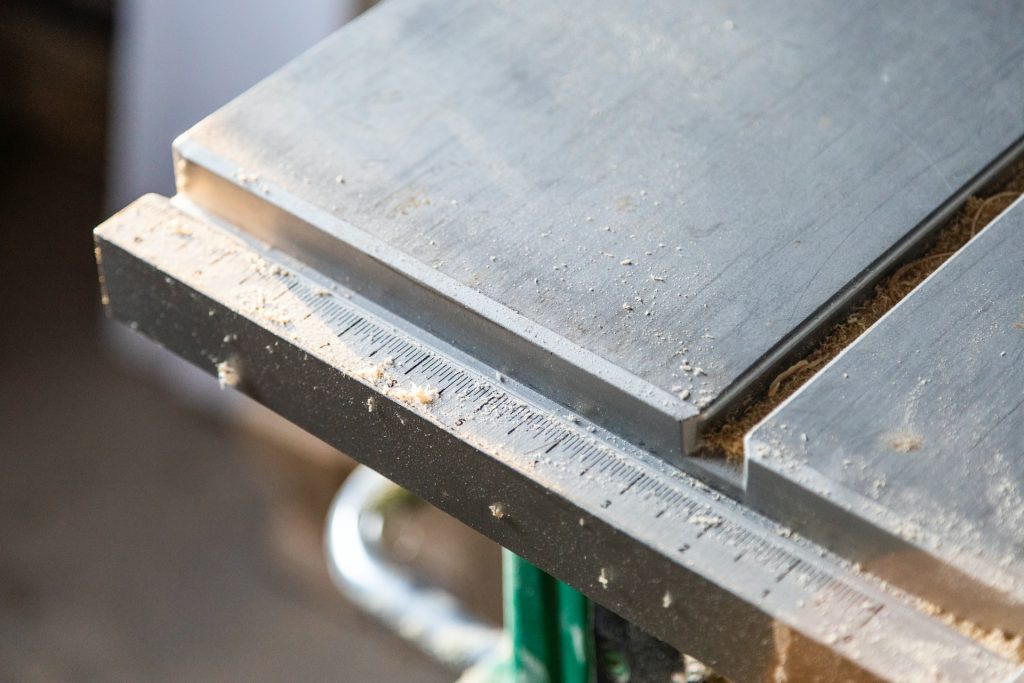Miter saws are great and versatile tools but in order to use them to their fullest potential, you need to understand how they work.
Miter saws can make cuts at many different angles but of course, there are different types of angles that you need to account for.
Quick Summary
In this post, we will explain what bevel means when we’re talking about miter saws.
We’ll also discuss what bevel cuts are and the differences between single-bevel and dual-bevel miter saws.
So without further ado, let’s get started.
Single-Bevel Miter Saw vs Dual-Bevel Miter Saw

Before we actually get into what makes single and dual bevel miter saws so different, you must first understand the difference between miter and bevel cuts.
Miter cuts are made across the width of the board. They are angled cuts but they do not change the angle at the end of the board that’s been cut.
Bevel cuts are angled cuts that are made through the depth of the board. Since they are angled cuts, they do change the angle at the end of the board that’s been cut.
Bevel cuts are typically used to adjoin two pieces of wood together to form a neat little corner. This is something that would not be possible with a miter cut because then, the boards would join at a right angle.
Now that you know what miter and bevel cuts are, let’s look at the differences between single-bevel and double-bevel miter saws.
A single-bevel miter saw consists of a saw blade that can be rotated (or beveled) typically in only one direction. For most miter saws, the direction is to the left. You can’t bevel it to the right.
On the other hand, a double-bevel or dual-bevel miter saw has a saw blade that can be rotated both left and right. So, it can make bevel cuts in both directions.
A dual-bevel miter saw can make your workflow much more efficient and quicker. This is because with a dual-bevel miter saw, you won’t have to turn your board around to make an identical bevel cut.
With a single-bevel miter saw, you would have to halt the process and turn the material around since the saw can only bevel left.
For most miter saws, the rotation (or bevel) can range from 0 degrees to 48 degrees.
Most miter saws come with pre-adjusted settings for most common angles that are used to make common objects in woodworking.
If you want to work on something more niche and complex, then you can fine-tune the angle according to however you want as well.
Pros and Cons of a Single and a Double-Bevel Miter Saw

After looking at the differences between a single and dual-bevel miter saw, you may feel that the latter is better overall.
However, the truth of the matter is that both miter saws have their merits and can be used in different situations. It’s all about figuring out which saw would be better for which situation.
To make this clearer, we’ve listed some advantages and disadvantages of both saws:
Single-Bevel Miter Saws
Pros
- Single-bevel miter saws are often much cheaper than dual-bevel miter saws. If you’re a woodworker on a budget, then you should definitely go for a single-bevel miter saw.
- Single-bevel miter saws are much easier to use than dual-bevel miter saws. They’re much more efficient as well if you’re mainly making 90-degree cuts.
- If you are new to woodworking, then single-bevel miter saws can be a great choice since they are much simpler to use. As a new woodworker, you probably will only work with straight cuts and single-bevel miter saws are the best for those.
Cons
- The most glaring disadvantage is the fact that single-bevel miter saws cannot be rotated or beveled to the right.
- Since you have to turn the workpiece around in order to make the cut on the other side, there’s a high chance that the two cuts may not be uniform. This will obviously cause your cuts to have an untidy and amateurish look.
- Single-bevel miter saws are much less efficient if you want to make angled cuts on both sides of the workpiece. This is because you have to halt the process and turn the workpiece around. This takes up a lot of time during cutting.
Dual-Bevel Miter Saws
Pros
- Dual-bevel miter saws are much more efficient at making angled cuts, especially if you need to make those cuts on both sides of the board. If you’re working on a project that requires many of these cuts, it makes sense to get a double-bevel miter saw.
- Dual-bevel miter saws offer a higher level of adjustment and fine-tuning when it comes to the angles of the cuts you can make. Hence, if you’re working on complex projects that require uncommon types of cuts, a dual-bevel miter saw will be very handy.
- They are a lot more accurate and precise compared to single-bevel miter saws. Hence, if you want to make fine and intricate cuts, then they can be a great choice.
Cons
- Double-bevel miter saws can be much more expensive compared to single-bevel miter saws. Hence, you might not be able to afford it if you’re on a budget.
- Even though they provide much finer tuning and adjustments, they are also a lot more difficult to operate. If you’re a novice, then you may have trouble properly operating a double-bevel miter saw. Hence, you wouldn’t use it to its fullest potential.
Should I Get a Single-Bevel or a Dual-Bevel Miter Saw?

The answer to this question will be different from person to person.
The fact of the matter is that you have to look towards what your needs are and then make a decision accordingly. This is a practice that you should always take before you decide to buy any power tool for your workspace.
Assess your needs first and then make a decision about which tool would be best for accommodating those needs.
If you’re a beginner woodworker that mostly makes straight, simple cuts. Then, you may not have much use for a dual-bevel miter saw. You wouldn’t really use its extra features and you will have effectively wasted your money.
On the other hand, if you’re an experienced woodworker that works on intricate, complex projects, then a dual-bevel miter saw might be for you. It would also be a good choice if you’re making repetitive angled cuts for any project on a regular basis.
In the end, it’s really about how much you need a dual-bevel miter saw and whether or not it would really add value to your workflow or not.
If you can get the job done with ease just by using a single-bevel miter saw, then you should do the smart thing and save your money.
Only spend the extra couple of hundred dollars to get a double-bevel miter saw if you really feel it would be valuable to your workflow.
Frequently Asked Questions (FAQs)

What Are Some Safety Precautions I Should Take When Using a Miter Saw?
Some safety precautions you can take before working with your miter saw include:
- Don’t wear loose clothing. Make sure no sleeves are loose that could get caught in any moving parts.
- If you have long hair, tie them up.
- Wear safety goggles or some type of eye protection to ensure any splinters or flying pieces of timber don’t go into your eyes.
- Wear some type of protective gloves to protect your hands from the fast-spinning blade.
- Ensure that your workspace is well-ventilated.
- Wear some sort of breathing mask to ensure you’re not breathing in sawdust and debris.
What Cuts Can Miter Saws Make?
Miter saws are specifically designed to make angled cuts, trim work, molding, and rafters.
They can also make straight cross-cuts if they are equipped with the appropriate saw blade. Miter saws make the woodworking process much more efficient and are also a great tool to have if you’re making repetitive cuts.
What is a Bevel Cut Used For?
A bevel cut can be described as an angled cut that is characterized by the top of the wood or board not being directly perpendicular to the edges.
You can make bevel cuts with a miter saw, a circular saw or a table saw. They have an angled edge that can be used for a number of different applications such as molding.
What’s the Difference Between a Chop Saw and a Miter Saw?
Chop saws are relatively much simpler tools compared to miter saws. They require a lot less expertise to operate and they are also used for much less sophisticated cuts.
Miter saws are typically used to make angled cuts in a precise and efficient manner. They are used by woodworkers to cut wood for cabinets, door frames, molding, etc.
How Long Do Miter Saw Blades Last?
Depending on the quality of the blade and the material you use the blade to cut, a blade can last you anywhere between 12 and 120 hours of continuous use.
What Does Bevel Mean on a Miter Saw? - Conclusion
This brings us to the end of our post on what bevel means when we talk about miter saws.
We hope you have a better understanding of how miter saws work now as well as more knowledge about which type of miter saw would be best for you.
Check put our website to get a better overview of bevels.
If you have any further questions, feel free to ask us in the comments section below.

